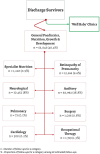Identifying and quantifying initial post-discharge needs for clinical review of sick, newborns in Kenya based on a large multi-site, retrospective cohort study
- PMID: 39391055
- PMCID: PMC11464310
- DOI: 10.3389/fped.2024.1374629
Identifying and quantifying initial post-discharge needs for clinical review of sick, newborns in Kenya based on a large multi-site, retrospective cohort study
Abstract
Background: Progress in neonatal care has resulted in a 51% decrease in global neonatal mortality rates from 1990 to 2017. Enhanced survival will put pressure on health care systems to provide appropriate post-discharge, follow-up care but the scale of need for such care is poorly defined.
Methods: We conducted a retrospective cohort study of newborns discharged from 23 public hospital neonatal units (NBUs) in Kenya between January 2018 and June 2023 to identify initial follow-up needs. We first determined pragmatic follow-up categories based on survivors' clinical conditions and morbidities. We then used individual phenotypes of individual babies to assign them to needing one or more forms of specialized clinical follow-up. We use descriptive statistics to estimate proportions of those with specific needs and patterns of need.
Findings: Among 136,249/159,792 (85.3%) neonates discharged, around one-third (33%) were low birth weight (<2,500 g), and a similar 33.4% were preterm (<37 weeks). We estimated 131,351 initial episodes of follow-up would be needed across nine distinct follow-up categories: general pediatrics, nutrition, growth & development (40.4%), auditory screening (38.8%), ophthalmology for retinopathy of prematurity (9.6%), neurology (8.0%), occupational therapy (1.3%), specialized nutrition (0.9%), surgery (0.8%), cardiology (0.2%), and pulmonary (<0.1%). Most neonates met the criteria for two (52.3%, 28,733), followed by three (39.6%, 21,738) and one follow-up episodes (5.6%, 3,098). In addition to prematurity and very low birth weight (≤1,500 g), severe infections with extended gentamicin treatment, severe jaundice managed with phototherapy, and hypoxic-ischemic encephalopathy (HIE) contributed substantially to the pattern of need for post-discharge follow-up.
Conclusions: Almost half of surviving NBU infants have multiple specialty post-discharge follow-up needs. More urgent attention needs to be focused on healthcare planning now to guide strategies to address the varied medical and developmental needs that we outline in resource-constrained contexts like Kenya.
Keywords: complications; follow-up; infant; morbidity; newborn; post-discharge; specialist.
© 2024 Wainaina, Lee, Irimu, Aluvaala, English and The Clinical Information Network Author Group.
Conflict of interest statement
The authors declare that the research was conducted in the absence of any commercial or financial relationships that could be construed as a potential conflict of interest.
Figures
References
-
- Kenya National Bureau of Statistics, Ministry of Health/Kenya, National AIDS Control Council/Kenya, Kenya Medical Research Institute, Population NCf, Development/Kenya. Kenya Demographic and Health Survey 2014. Rockville, MD: Kenya National Bureau of Statistics (KNBS) (2015).
LinkOut - more resources
Full Text Sources
Miscellaneous



